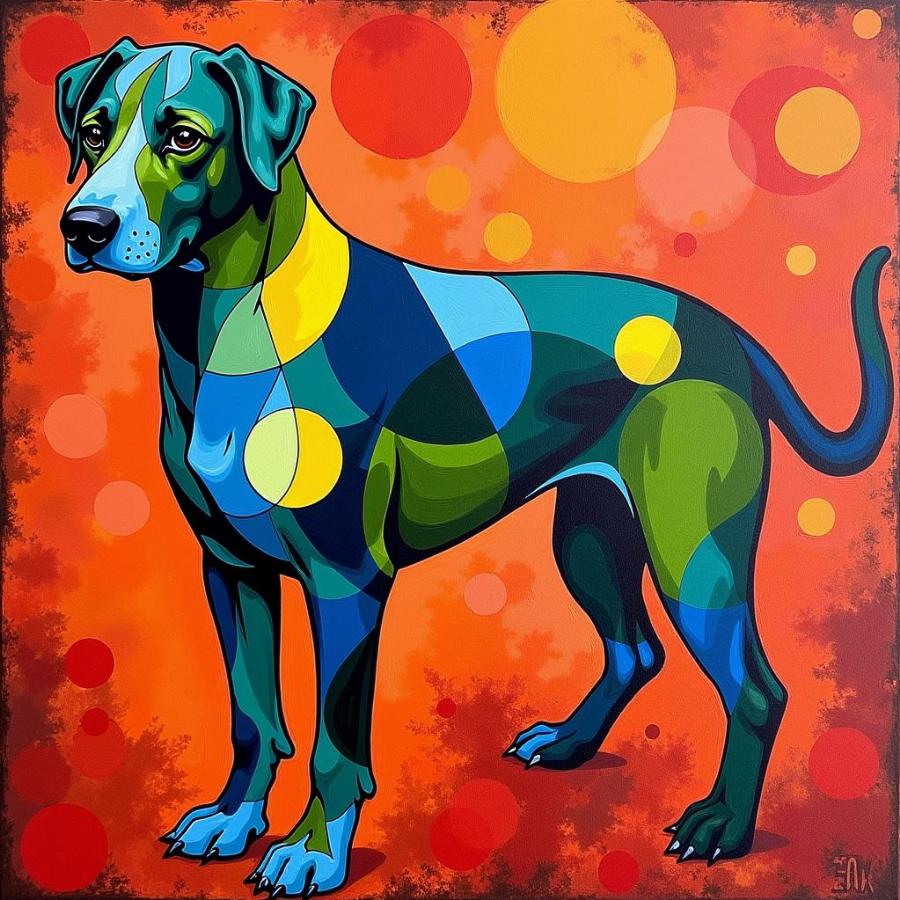Painting a dog, whether from a photograph or real life, presents unique challenges and rewards. It’s a way to immortalize your furry friend, capture their unique personality, and celebrate the bond you share. But where do you start? This comprehensive guide explores the fascinating world of dog paintings, covering everything from choosing the right medium to understanding canine anatomy and capturing that special spark in their eyes.
Getting Started with Your Dog Painting
Before you even pick up a brush, consider what kind of painting you envision. Do you prefer the vibrant strokes of oil paints, the delicate washes of watercolors, or the versatility of acrylics? Each medium offers a different aesthetic and requires specific techniques. dog paintings in oil offer a richness and depth of color, while watercolors lend themselves to a more ethereal and expressive style. Acrylics, known for their quick drying time and vibrant hues, are a great option for beginners.
Choosing your subject is just as important. Will you be working from a photograph or painting your dog from life? If working from a photograph, choose a clear, well-lit image that captures your dog’s personality. If painting from life, ensure your furry friend is comfortable and has plenty of breaks.
Understanding Canine Anatomy for Realistic Dog Art
While artistic license is always welcome, understanding basic canine anatomy will elevate your dog painting to the next level. Focus on the underlying bone structure and muscle groups that give dogs their characteristic shape. Pay attention to the proportions of the head, body, and legs. Observe how the muscles move and flex beneath the skin and fur.
Consider the specific breed you’re painting. A Greyhound’s sleek, muscular form differs drastically from the fluffy, rounded shape of a Pomeranian. dogs gaming painting can also provide inspiration for dynamic poses and expressive depictions of dogs.
Capturing the Spirit of Your Canine Companion
What truly brings a dog painting to life is capturing the dog’s unique spirit. Is your dog playful and mischievous, or calm and dignified? Their personality should shine through in your artwork. Pay attention to their eyes – the windows to their soul. Capture the sparkle, the curiosity, the unwavering love that makes your dog so special.
“The key to a successful dog portrait is not just capturing the physical likeness, but also the emotional connection,” says renowned animal portraitist, Amelia Shepherd. “Focus on the subtle nuances of their expression, the way their ears perk up, the tilt of their head. These are the details that tell their story.”
Tips and Techniques for Painting Dogs
- Start with a sketch: Lightly sketch the basic shapes and proportions of your dog before applying paint. This will help you maintain accuracy and avoid major corrections later on.
- Layer your colors: Build up the colors gradually, starting with thin washes and adding thicker layers for depth and detail. This allows for greater control and creates a more realistic effect.
- Focus on the eyes: The eyes are the focal point of any animal portrait. Take your time and pay close attention to detail when painting the eyes.
- Don’t be afraid to experiment: Try different brushstrokes and techniques to create texture and movement in your painting.
What Colors Best Represent My Dog?
Choosing the right colors is crucial for a realistic and captivating dog painting. Observe your dog’s coat carefully. Is it a solid color or a mix of shades? Are there any unique markings or patterns? Use a variety of hues and tones to create depth and dimension. Don’t be afraid to exaggerate colors slightly to enhance the visual impact of your painting.
 Acrylic painting of a dog in an abstract style
Acrylic painting of a dog in an abstract style
Conclusion: Celebrating the Canine Bond Through Art
Painting your dog is a rewarding experience that allows you to express your love and appreciation for your furry companion. Whether you choose a realistic or abstract style, the process of capturing their unique personality on canvas is a testament to the special bond you share. So, gather your materials, embrace the creative process, and celebrate the canine charm that enriches our lives. Remember, the most important aspect of painting your dog is to have fun and enjoy the journey!
FAQ: Frequently Asked Questions about Painting Dogs
- What is the best medium for painting dogs? The best medium depends on your personal preference and skill level. Oils, watercolors, and acrylics are all popular choices.
- How do I capture my dog’s personality in a painting? Focus on their eyes, expression, and body language. Observe their behavior and try to capture their unique quirks and mannerisms.
- What if my dog won’t sit still? Try working from a photograph or using short posing sessions with plenty of breaks and treats. calming peanut butter for dogs can be helpful in these situations.
- How do I choose the right colors for my dog’s coat? Observe your dog’s coat carefully in different lighting conditions. Use a variety of hues and tones to create depth and dimension.
- Where can I find inspiration for dog paintings? Look at the work of other animal artists, browse online galleries, or visit art museums. dog art paintings can provide excellent inspiration.
Further Exploration:
- Learn more about specific dog breeds and their unique characteristics.
- Explore different painting techniques and styles.
- Consider taking a class or workshop to improve your skills.
- Research famous dog paintings like picasso dog painting for inspiration.
Beaut Dogs is your ultimate resource for all things canine, providing trusted information on breed characteristics, care guides, and product recommendations. When you need expert advice, email us at [email protected] for detailed and accurate answers. Beaut Dogs is dedicated to helping you provide the best possible care for your beloved furry friend. Visit us at https://beautdogs.com.